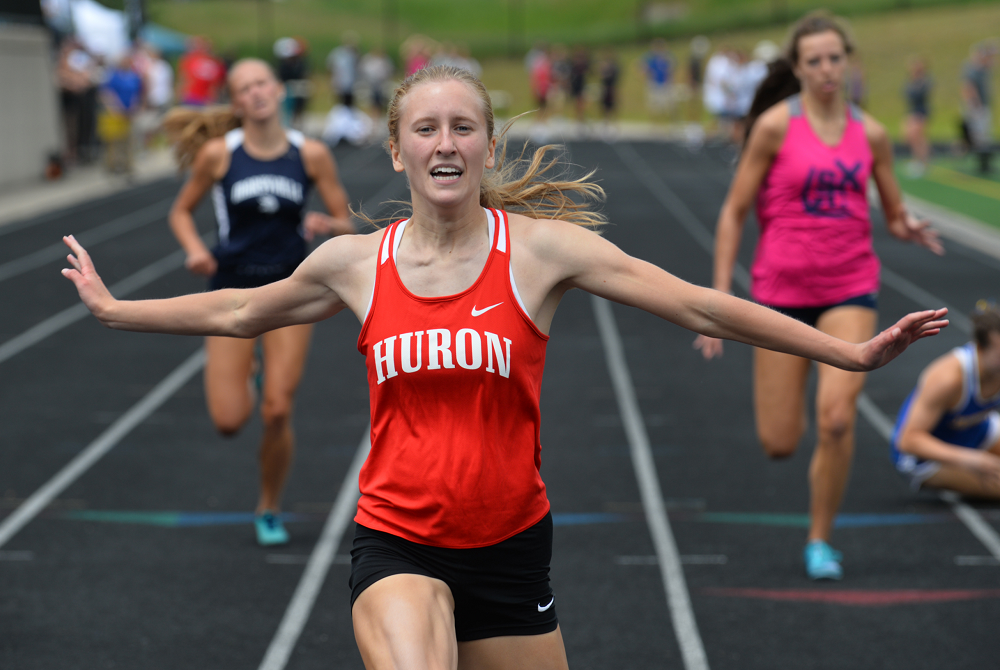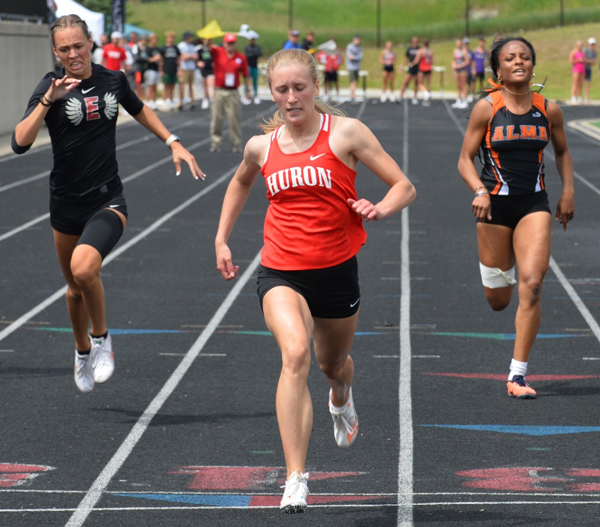
Stockford Reigns, Ithaca Earns 1st Title
June 4, 2016
By Jeff Chaney
Special for Second Half
COMSTOCK PARK – Last year Hailey Stockford came out of nowhere to win a pair of sprinting championships at the MHSAA Lower Peninsula Division 3 Track & Field Finals at Comstock Park High School.
This year, all eyes were on her.
As the reigning champion in the 100 and 200-meter dashes, the Sanford Meridian senior knew everyone at this year's Finals on Saturday, again at Comstock Park, wanted to dethrone here.
That was wishful thinking, as Stockford easily repeated in both events, winning the 100 in 12.27 seconds and the 200 in 25.29.
"It is a little harder to defend, because last year was my first year in track and no one knew who I was," said Stockford, who will be continuing her career at Saginaw Valley State University on a full scholarship. "This year I had the target on my back, and I don't know if I liked that. But I knew I was capable of dealing with it."
Those might have been the last of a long list of defenses for Stockford, but she started running track only last year as she also was a star on her school's softball team.
But her speed could not be ignored.
"In gym class, I ran the 40-yard dash and had a good time, and my coach, Mike Bilina, said I should really go out for track," Stockford said. "I played softball, but decided it was a good idea, and went out. Glad I did; it paid off."
Stockford's were two of many great performances on a perfect day for track and field. But collectively as a group, the day belonged to Ithaca, which won its first MHSAA team title in the sport with a score of 57.5 points, 3.5 more than runner-up Adrian Madison.
"Our goal coming in was to win," Ithaca coach Gene Lebron said "We scored 38 points last year and finished in fourth, and we didn't lose anybody. I am so proud of these girls, and so proud of the work they put in."
 Ithaca was led to its title by senior Erica Sheahan, who repeated in the long jump with a leap of 17-10.25.
Ithaca was led to its title by senior Erica Sheahan, who repeated in the long jump with a leap of 17-10.25.
When talking about the Bullough family of Traverse City, a word that comes to mind is toughness.
That was never so true than Saturday, as St. Francis' Holly Bullough, younger sister of Max, Byron and Riley Bullough – who all played, or are now playing, football for Michigan State University – ran with a stress fracture in her left foot.
With a foot that requires a walking boot when she is not competing, Bullough won the 1,600 with a meet record time of 4 minutes, 52.63 seconds.
She also won the 800 in a time of 2:12.22 and was a member of the Gladiators' 1,600-meter relay team that took second with a time of 4:03.07.
"When I run, it's not as bad, but it really hurts after," said Bullough, who will be joining Byron and Riley at MSU this fall. "I felt good today. I haven't had a meet in a week and a half, so I have just been cross training. Today I just needed to get back into a rhythm."
Clare's Kasey Staley had a busy 10 minutes in her Finals events, as she ran for her team's 800-meter relay team that set a new school record of 1:46.91 and took third, and then came back to win the pole vault with a vault of 12 feet, 4 inches – a new meet record.
"The adrenaline was pumping," said Staley, a junior. "I did feel nervous because I just ran in the relay and came back to the pit. I made 11-8, and then went for 12-4 and when I made it on my second jump, it was the greatest feeling in the world."
PHOTOS: (Top) Sanford Meridian's Hailey Stockford (far left) is announced as the 100 meter champion Saturday at Comstock Park. (Middle) Ithaca's Emily Foster competes in the 300 hurdles; she finished fifth. (Click to see more from HighSchoolSportsScene.com.)

Multi-Sprint Champ Racing to Finish Huron Career Ahead of the Rest Again
By
Keith Dunlap
Special for MHSAA.com
May 25, 2023
NEW BOSTON – If there was one thing Elizabeth Anderson took pride in elementary school, it was simply showing that she could outrun everyone in sight.
 In fact, Anderson has an explanation for all the success she had in those playground races.
In fact, Anderson has an explanation for all the success she had in those playground races.
“Dominance when you are in elementary school,” Anderson quipped. “I don’t think I ever had a nickname. I just think everyone knew I was fast.”
Years later, pretty much everyone who follows track & field in the state of Michigan can attest to that.
A senior for New Boston Huron, Anderson has been faster than most other competitors in the state during her three-year high school career (with her freshman season in 2020 canceled due to COVID-19).
Last year, Anderson won titles at the Lower Peninsula Division 2 Finals in the 200-meter (25.07) and 400-meter (56.28) dashes, and was runner-up in the 100-meter dash (12.23).
Often, top sprinters focus on one or two of those three races. But Anderson is certainly a different breed of sprinter because she does all three.
In fact, she holds school records in all three of those events, and if all that weren’t enough, Anderson is a part of all three sprint relay teams.
“It is hard to give her events off,” said New Boston Huron head girls track coach Danielle Lobato.
Despite the different styles the 100, 200 and 400-meter dashes present, Anderson said there usually isn’t much adjusting when she goes from one of those races to another.
 The strategy is simply, “Let’s beat the other girls to the finish line.”
The strategy is simply, “Let’s beat the other girls to the finish line.”
“I don’t really go into each race changing up how I would run,” she said.
While enjoying and succeeding in all three races, Anderson said she actually does have a favorite among them.
“I would say the 400 is probably my favorite,” she said. “Even though it hurts, it’s satisfying to see how much you can get your time down in the 400 compared to any other race.”
Anderson said she started running track in sixth grade, but really got serious about it during the summer after her sophomore season, when she was invited to run for a local club.
Eventually, that led to her competing over the winter in indoor events.
She lived and breathed track so much that last fall, she decided to not run cross country so she could focus on a weightlifting regimen aimed at developing more leg strength.
“Once I started doing summer track, I realized I wanted to be doing this all the time,” she said.
Lobato said oftentimes in practice, Anderson is a de facto coach, given there is no better person she can think of for the younger runners on the team to learn from.
“I can’t always demonstrate these things I’m trying to teach,” she said. “You get to see it in real life (from Anderson), not in a YouTube video.”
After winning the 100, 200 and 400-meter dashes at her Regional meet last week, Anderson has her sights set on achieving the same trifecta of titles at next Saturday’s Finals in Grand Rapids.
Anderson has signed to run track at Michigan State, but has been plenty motivated to keep producing this spring in her final high school season.
“I’m really looking to defend my titles,” she said. “That is what is really motivating me to keep going. I want to keep in shape for the college season. I don’t want to lose any of the progress I have made. Ultimately, I just love running track.”
And since elementary school, Anderson has loved — and succeeded in — outrunning everyone else to the finish line.
“We knew we were getting something special,” Lobato said of when Anderson arrived in high school. “But you never expect this. All that she has accomplished is amazing.”
 Keith Dunlap has served in Detroit-area sports media for more than two decades, including as a sportswriter at the Oakland Press from 2001-16 primarily covering high school sports but also college and professional teams. His bylines also have appeared in USA Today, the Washington Post, the Detroit Free Press, the Houston Chronicle and the Boston Globe. He served as the administrator for the Oakland Activities Association’s website from 2017-2020. Contact him at [email protected] with story ideas for Oakland, Macomb and Wayne counties
Keith Dunlap has served in Detroit-area sports media for more than two decades, including as a sportswriter at the Oakland Press from 2001-16 primarily covering high school sports but also college and professional teams. His bylines also have appeared in USA Today, the Washington Post, the Detroit Free Press, the Houston Chronicle and the Boston Globe. He served as the administrator for the Oakland Activities Association’s website from 2017-2020. Contact him at [email protected] with story ideas for Oakland, Macomb and Wayne counties
PHOTOS (Top) New Boston Huron's Elizabeth Anderson clears the finish line during last season's LPD2 400 race. (Middle) Anderson, middle, outpaces the field to also win the 200. (Click for more from RunMichigan.com.)

